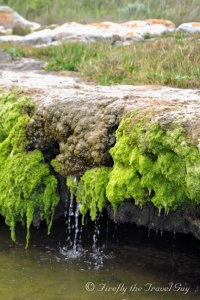One of the aspects of Geocaching is something called an Earth Cache. An Earth Cache isn ‘t a physical cache where you have to find a container but rather something that teaches you about the earth and it’s geology. Last weekend I did an Earth Cache in Schoenmakerskop set up by Seekoei NMB called PE Tufa stromatolite ecosystems. What is Tufa stromatolite? Please bear with me because this get’s very scientific (which means I’m copy and pasting from the listing otherwise I may just be misinterpreting the information.
Tufa is a variety of limestone, formed by the precipitation of carbonate minerals from ambient temperature water bodies. Geothermally heated hot-springs sometimes produce similar (but less porous) carbonate deposits known as travertine. Tufa is sometimes referred to as (meteogene) travertine. Care must be taken when searching through literature to prevent confusion with hot spring (thermogene) travertine. Calcareous tufa should not be confused with tuff, a porous volcanic rock with parallel etymological origins that is sometimes called “tufa”.
This now is where the Tufa stromatolite discoeverd at Schoenies comes in.
The first extant marine tufa stromatolites along the southern African coast were described in the early 2000s from Cape Morgan and later investigated in some detail from a geochemical and geomorphological point of view. Located on a dolerite headland shaped into a wave-cut platform, these stromatolites consist of continuous, extensive laminar growths or discrete accretions bridging gaps between separate boulders. In either case, the formation results in enclosed rock pools capable of trapping carbonate-rich groundwater seeps.
Although other rare, isolated examples of similar formations have been reported to occur from Port Elizabeth to Tofu in Mozambique, the recent discovery of numerous and closely spaced living stromatolites on the coastline south of Port Elizabeth appears to be extraordinary.
While the Cape Morgan headland includes about 50 stromatolite colonies, each of about 3 m2 on average, the formations mapped so far to the west of Cape Recife include 540 colonies, ranging in cover from 100 m2.
Southern African tufa stromatolites are regarded as unique in their nature, because they typically occur at the interface between freshwater seepage points and the marine penetration. I know this is all a mouth full, but if you read through it carefully and understand it, it really is something very interesting and unique.

How interesting !!!
Hi Jonker, I did read it through and I did find it interesting and unique. I love how South Africa so often has something unique like the fact that these tufa stromatolites occur where there is fresh and marine water. Awesome. Thanks for sharing. Greetings Jo